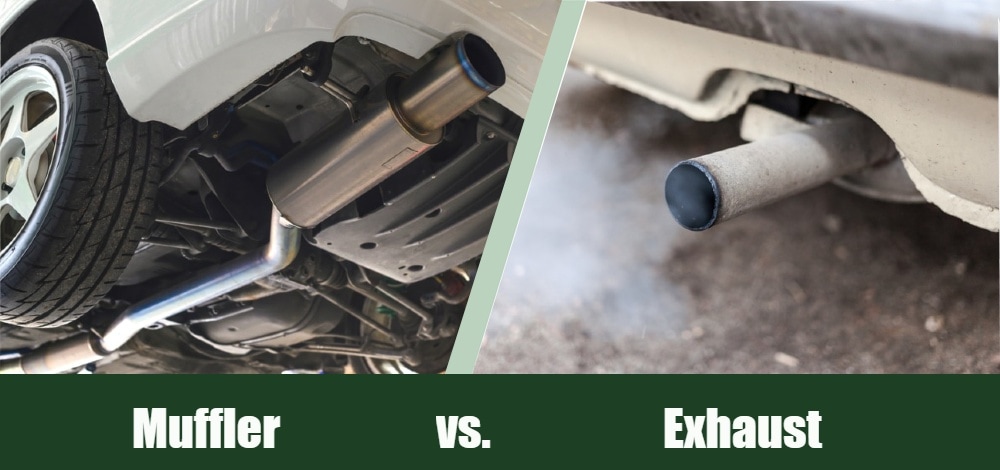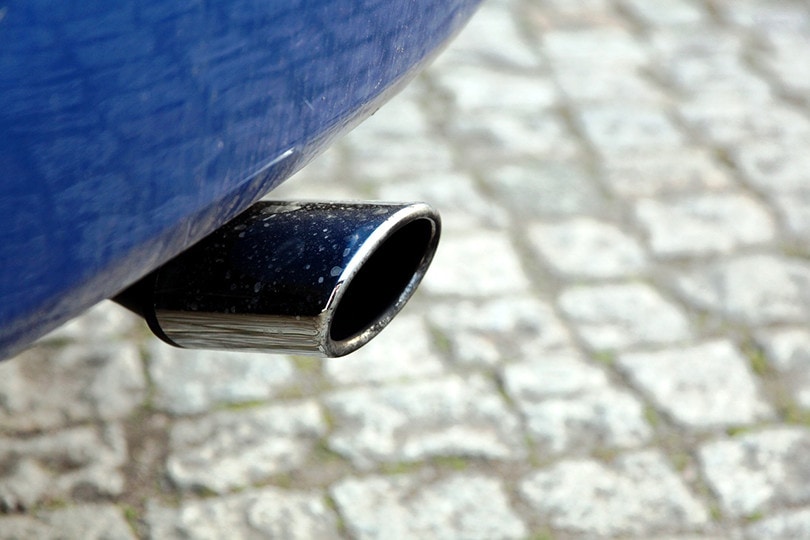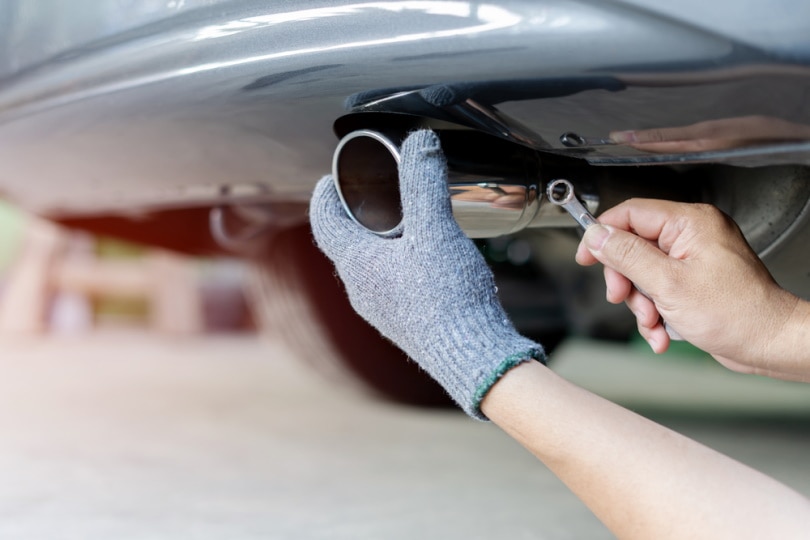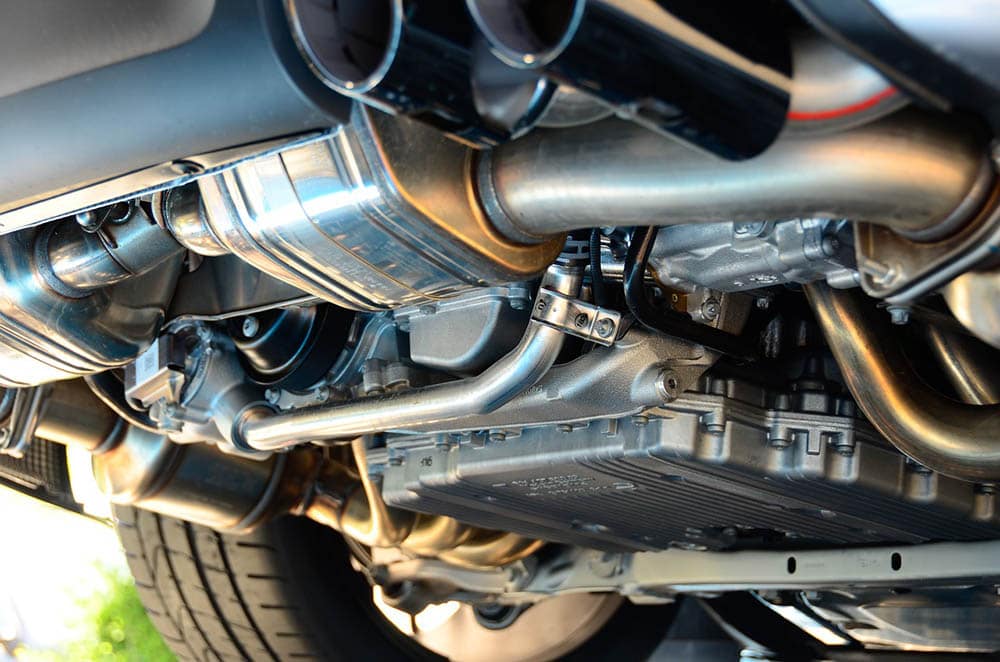Muffler vs. Exhaust: Pros, Cons & Differences
-
Pete Ortiz
- Last updated:

The exhaust system of a car is responsible for taking harmful gases produced by an engine, making them safe, and directing them away from passengers and into the external atmosphere. A muffler, although it forms part of the exhaust system, muffles or quiets the sound of the engine and exhaust. Although they are both responsible for reducing by-products produced by the engine, the muffler and exhaust perform different roles. However, some people incorrectly use the terms interchangeably.
Read on to learn more about these two elements of your car.
Overview of the Muffler

A car engine produces a lot of power and, in doing so, creates vibrations and a series of noises. These noises not only emanate from the engine itself but pass through the exhaust pipe and the rest of the exhaust system. Thousands of vibrations are created every minute and it is the job of the muffler to dampen these noises. Without a fully functioning muffler, engine and exhaust noises would be unbearable.
How Does It Work?
The muffler inlet is attached to the exhaust system, directing gases and noise into the muffler. From here, it passes through a resonator that dampens sound by muting sound waves. Perforated tubes work to further reduce noise while also increasing your car’s performance and, finally, an outlet exhausts the remaining gases and sound from your car.
Mufflers don’t just dampen noise but introduce engine noises to other sound waves that effectively cancel one another out. The use of different sound waves and muffler design means that while some mufflers work to completely eliminate noise, others will intentionally emit a grumbling or growling noise.

Signs of a Bad Muffler
A bad muffler not only means that your car will make more noise, but it can mean that toxic gases are not being exhausted from the car properly and that your car may suffer from a loss of performance. Therefore, it is important that you are able to spot the signs of a bad muffler.
- Because the main purpose of a muffler is to reduce noise, the most obvious sign that yours is failing is an increase in exhaust noise. Whether idling or driving, the noise will be obvious inside and outside the car. As well as louder engine noises, you may also notice rattling, which could indicate that the muffler has detached from the rest of the exhaust system or has cracked.
- You may be able to see signs of rust or cracks in the muffler. These are typically identified by raising the car and getting underneath to inspect properly.
- Although some drops of condensation are normal, if you see a stream of water coming from the muffler, it could mean it is damaged and in need of repair.
- A failing muffler can cause the car engine to overheat. Run the car for a short period and check the engine temperature. If it is running hot, have somebody inspect the vehicle to determine whether a damaged muffler is the cause.
- Reduces engine noise
- Improves performance and endurance of the vehicle
- Some mufflers can intentionally generate a grumbling or growling noise
- An essential component of your car
- Mufflers can become damaged or fail completely
- Even a tiny crack or hole can prevent the muffler from working efficiently
Overview of the Exhaust

A car engine produces toxic gases and the power needed to run the engine also creates a lot of vibration and noise. The exhaust system extracts gases from the engine, treats them, and vents them out of the car and away from vehicle occupants. The muffler, which is a component of the exhaust system, controls engine noise and dampens vibrations. A good exhaust system can also improve fuel efficiency and ensures that emissions are kept to a minimum.
How Does It Work?
Gases are gathered from the engine via the exhaust manifold. The manifold funnels all gases from all cylinders in the engine and passes them through a single pipe, called the front exhaust pipe. The gases are passed through a catalytic converter to remove toxic elements like carbon monoxide, and these are converted into safe, inert gases.
The inert gases then pass through the muffler, which dampens sound and cancels out the noise of vibrations. Once the gases have passed through the muffler, they are passed out through the tailpipe.
Signs of a Bad Exhaust
Like the muffler, the exhaust is a critical component of the car that not only minimizes noise but also prevents passengers from being exposed to toxic gases and deadly fumes. Any damage should be fixed as soon as possible to ensure safety. As well as the signs of a bad muffler highlighted above, other symptoms of a damaged or failing exhaust system include:
- If the exhaust manifold gasket is damaged, it can cause gases to escape from the system, which often manifests as a hissing sound from the engine. Also, listen for any suspicious sounds coming from the car.
- One of the components of the exhaust, the catalytic converter, helps to eliminate gases like carbon monoxide. If it fails, you will be able to smell these gases inside the car. Fortunately, they do have a noxious smell that is usually easy to detect.
- Increased fuel consumption is another possible sign of a bad exhaust. If the system is blocked, it causes pressure in the exhaust system and this reduces engine efficiency, which will be noticeable at the pump.
- Similarly, when you accelerate, you may notice damp patches in your acceleration. Your car won’t pull away when you put your foot down.
- Physical signs of damage include rust and corrosion, but you may also notice part of the exhaust system effectively hanging down from under the car. This can be noticeable without having to jack the car up, as you may be able to see pipes hanging under the car.

- Vents toxic gases from the car and away from passengers
- Improves engine performance and fuel consumption
- Reduces emissions to a safer level
- An essential component in the safe running of your car
- Exhaust systems can become damaged, corroded, or rusted
- A bad exhaust means increased fuel consumption and reduced engine performance
Is a Muffler and an Exhaust the Same Thing?
A muffler and an exhaust are not the same. The muffler is part of the exhaust system and is responsible for reducing noise and vibrations created by the engine and the exhaust system. The exhaust system deals with all the by-products of the engine, including noise, but primarily diverts toxic gases away from vehicle occupants and reduces the emissions that a car produces.

Can You Drive Without a Muffler or Exhaust?
Whilst it may technically be possible to drive without a muffler or an exhaust, it isn’t safe to do so. Without a muffler, toxic gases will be expelled from the bottom of the vehicle and can make their way into the cabin of the car. This means that you could be exposed to dangerous emissions like carbon monoxide. Not to mention, the noise produced by your car would likely be unbearable and the engine will be prone to overheating. The same is true of an exhaust system. The car may run without one, but it isn’t safe to drive.
Which Is More Expensive?
Mufflers cost between $100–$300 for parts alone, while the tailpipe of an exhaust will usually cost around $100. A whole exhaust system, on the other hand, can cost up to $1,000, although this does include the cost of the muffler. While nobody wants to have to pay these kinds of costs for car repairs, the exhaust and the muffler prevent you and your passengers from inhaling toxic gases and it is vital that you do have repairs made as soon as possible, to prevent illness.

How Can I Tell Which Needs Replacing?
The muffler is part of your exhaust system, and it can be difficult to self-diagnose whether it is this or another component of the system that has been damaged. With that said, if you can hear a hissing sound, it is likely a gasket that is broken, rather than the muffler. And, if you can see a pipe hanging down under the car, it means that the damage is likely to be to your front pipe and not the muffler. However, if your car is making more noise than usual or you are experiencing any other possible symptoms of a damaged exhaust, you should get it checked out to determine the exact problem.
Conclusion
The muffler is one component of an exhaust system. It reduces engine noise and vibrations. The exhaust, as a whole, eliminates other by-products, as well as noise. It vents toxic gases away from the car cabin, therefore protecting passengers, and it eliminates or minimizes emissions, therefore protecting passers-by and the environment as a whole.
You Might Also Be Interested In:
- https://www.sundevilauto.com/what-is-a-muffler-and-what-does-it-do/
- https://www.sundevilauto.com/muffler-vs-exhaust-whats-the-difference/
- https://www.dwellsautomotive.com/blog/difference-between-the-muffler-and-the-exhaust
- http://www.differencebetween.net/object/auto-object/difference-between-muffler-and-exhaust/
- https://www.midas.com.au/is-there-any-difference-between-a-muffler-and-an-exhaust/
- https://resource-center.meineke.com/when-do-i-need-to-replace-my-muffler/
- https://www.ronstireandautorepair.com/About/News/ArticleID/9878
- https://www.kwik-fit.com/exhausts/information/how-exhausts-work
- https://www.yourmechanic.com/article/how-exhaust-systems-work
- https://gomechanic.in/blog/symptoms-of-a-bad-exhaust-system/
- https://completecar.ca/maintenance/can-you-drive-without-a-muffler/
Featured Image Credit: Left: Muffler: Setta Sornnoi, Shutterstock | Right: Exhaust: Alexander Ishchenko, Shutterstock
Contents


